Foraging is a great way to enjoy the outdoors, take in scenic views and return home with some native delicacies for your kitchen! Always use caution when identifying foraging species as some mushrooms, for example, can be poisonous if ingested. A good ID book will help you identify the best the forest has to offer. As a responsible forager, a good rule of thumb is to leave at least 30% of what you found in the forest.
Chanterelles
Chanterelles are really nice mushrooms that can be found throughout most of the summer and early autumn, and they are easy to identify. Look for chanterelles along hardwood tree roots (often oaks and beech). Once you find a patch of chanterelles, mark it, as these mushrooms will return year after year in that same spot. These mushrooms are fantastic sauteed and pair nicely with a venison steak and fresh thyme.The most common look alike to chanterelles in the fall woods is the Jack O Lantern mushroom. This one, while gorgeous, will make you sick so be confident in your identification of chanterelles.
Lobster Mushroom
Lobster Mushroom is a late summer, early autumn treat. These don't really look like mushrooms; more like a heavy, warty growth. They are found in the same areas as chanterelles, have a seafood-like taste, and are delicious.
Chicken of the Woods
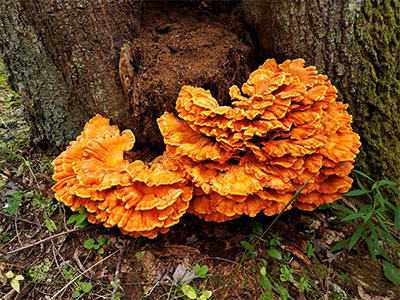
Chicken of the Woods is a popular fall mushroom, typically found after rainfall. This is a shelf mushroom, and it grows on the wounds of living trees but can grow on dead trees as well. This one is easy to spot because it is orangish-yellow and grows in brackets or shelves. It is a firm mushroom, hence its given name, Chicken of the Woods. It is delicious, and like many mushrooms, it takes on the flavor of the ingredients used. Battered and fried, these mushrooms taste just like fried chicken.
Hen of the Woods or Ram’s Head Mushroom
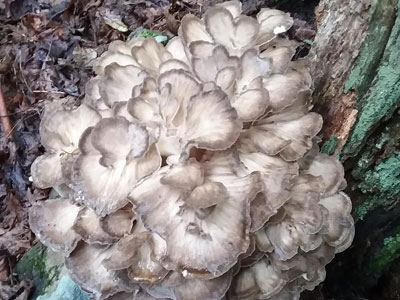
This is a late summer/early fall mushroom, often called maitake by chefs. This one is really easy to identify and is abundant (much like Chicken of the Woods). It is great sliced up and put in any recipe calling for mushrooms. Hen of the Woods are a personal favorite of many foragers.
Honey Mushroom
Honey Mushroom, a root rot fungus, is also known as Armillaria. This mushroom is abundant in our overmature oak forests, and they often grow in the same areas as hen of the woods. Honey mushrooms are tasty, but they have some lookalikes that are deadly, so reference a trusted guide book while foraging for Honey Mushroom.
Puffball Mushroom
These mushrooms are found during the fall months and are not really flavorful. However, they add a nice texture to a hummus dip without overpowering the other flavors.
Lion's Mane Mushroom
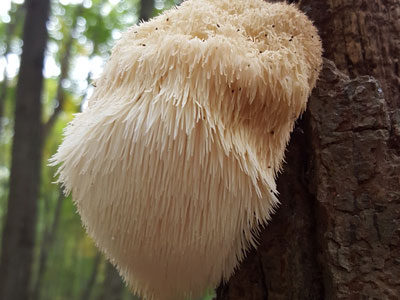
This mushroom grows on maples, hickories and oaks, and it’s usually high enough up in a tree that you have to get creative to knock it down. Another fall mushroom, you can find these delicacies throughout the month of October. They have a seafood-like flavor and are a well known ingredient in mock crab cakes.
Tree Nuts
Native Americans relied upon this food source, as did early settlers who used the crop as feed to fatten livestock. Tree nuts include but are not limited to black walnut, hickory, beech, chestnut, and for the brave, acorns.
Hickory nuts are delicious; better than pecans. They are not the easiest nut to crack, but worth the effort. Hickory nuts are great in muffins and cookies. If you do not have the patience to crack them, these nuts can just be crushed up, steeped and strained to make hickory milk - the best coffee creamer around.
Black walnut trees are a nuisance for most. They are not the greatest shade tree for a lawn and produce toxic compounds around themselves that exclude some plants (especially those in the nightshade family like tomatoes). During autumn, black walnuts fall from the trees and create havoc for cars, people, and roofs. However, the nut meat is bold and delicious, even if you have to work to get to it. The husk of the walnut needs to be removed while wearing gloves as the dye will stain your fingers black for weeks. The nuts are then ready to be dried and stored. When ready to eat, they must be cracked open. This is a hard step, but machines exist, or you can do it with a hammer. If you are used to cooking with English walnuts, as a rule of thumb, cut the nut portion of the recipe in half. Mock banana nut bread made with pawpaw and black walnut is divine.
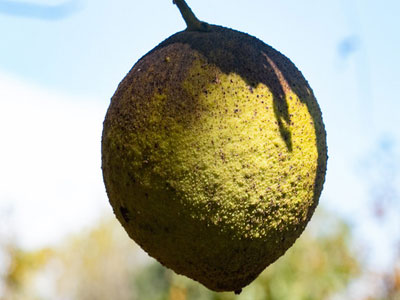
Beech nuts are an easily identifiable tree with bark like an elephant's skin. If you find a beech that has set fruit, you will often find every animal in the forest there. Why? Because beechnuts are delicious! If you have the patience to collect them, you will find that they are enclosed in a spiny husk. Inside this husk are 2-3 little chestnut-like nuts with tiny little nuggets of nut meat that can be eaten raw in the woods or taken home and roasted. They are great in baked goods, or just as is.
American chestnuts are rare to find in our forests, due to chestnut blight. That said, Chinese and European chestnuts were widely planted for their tasty nut meat. The spiny husk is a challenge, but inside are nuts that when roasted and cracked, produce wonderful food.
Hickory Bark
Hickory bark can be roasted and steeped to make a hickory tea, and with the addition of sugar, the tea can be reduced over heat to make hickory syrup. Never rip the bark off the tree, rather pick up what has exfoliated and is on the forest floor around the trees.
Pawpaw
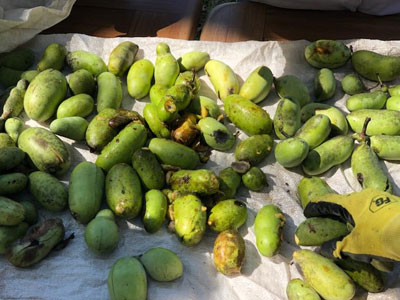
Pawpaws, the largest edible fruit trees native to North America, produce greenish-blackish fruit, usually three to six inches long. The flesh is pale to bright yellow and contains many mahogany colored seeds. A pawpaw's flavor is a combination of mango-banana-citrus. Some consider the backnotes to have a subtle kick of a yeasty, floral aftertaste. The fruit can be eaten ripe or taken home, but it will perish quickly. This is the primary reason it has not been commercialized. Pawpaws ripen in mid-September, and are great mixed in with ice cream or in recipes that call for bananas.
Persimmons
American persimmons are smaller than their Asian counterparts.Experienced hunters have witnessed deer leave corn to feed under a persimmon tree. However, these fruits are extremely unpleasant when unripe. After a frost, when the partially rotten fruit falls to the ground, quickly gather it up to eat fresh, or use persimmons in baked goods or jams.